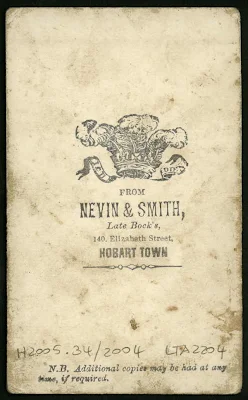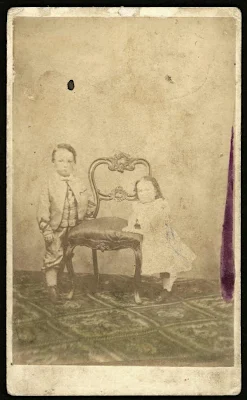On the day fixed for his departure from Tasmania, 18th January 1868, H.R.H. Prince Alfred was presented with an album of photographs. The album's contents were described in the report of the visit written by John George Knight as follows:
... eighty three photographs illustrative of the scenery of Tasmania, forty eight portraits of children born in the colony, and nine plates immediately connected with the Prince's visit.
The full article included these details:
TRANSCRIPT
... on Saturday 18th January (the day fixed for his departure) on board the Galatea, to his Excellency the Governor, Mrs Gore Browne and Miss Gore Browne, Her Majesty's Ministers, the Chairman of the Reception Committee, the Hon JM Wilson MLC, and Mr Tarleton and advantage was taken of this farewell interview to place in the Prince's hands the album of photographs of Tasmanian scenery which had been prepared under the direction of the Reception Committee for presentation to him from the colonists as a memorial of his visit. The album contained eighty three photographs illustrative of the scenery of Tasmania forty eight portraits of children born in the colony and nine plates immediately connected with the Prince's visit. The title page was drawn by Mr Alfred Randall and illustrated by Mr WC Piguenit. His Royal Highness was pleased to request that the Reception Committee would furnish him with duplicate copies of all the pictures for the illustration of a work which his Royal Highness is preparing in connection with his visit to the Australasian Colonies. After the presentation the guests sat down to luncheon with his Royal Highness in the state reception saloon of the Galatea. Lord Newry and the Prince's suite were also present. The Prince's guests bade their Royal host farewell about half past two pm when steam was got up and the anchors were weighed. At three o clock the noble vessel steamed slowly down the estuary of the Derwent and the Prince bidding adieu to Tasmania proceeded on his voyage to Sydney.Source: p210, Narrative of the visit of His Royal Highness the Duke of Edinburgh to the colony of Victoria, Australia by John George Knight. Available at Google books.
Although none of those forty-eight (48) photographs of children has been identified as such, this portrait produced by commercial photographers Thomas J. Nevin and his partner Robert Smith, operating as the firm Nevin & Smith from 1867 to February 1868, may have been intended for inclusion.


STATE LIBRARY OF VICTORIA
[Studio portrait of two children] Nevin & Smith.
Creator: Nevin & Smith, photographer.
Title: [Studio portrait of two children] [picture] / Nevin & Smith.
Access/Copyright: Reproduction rights: State Library of Victoria
Accession number(s):H2005.34/2004, H2005.34/2004A
Date(s) of creation: [ca. 1867-ca. 1875]
Medium: 1 photographic print on carte de visite mount : albumen silver, hand col. ;
Dimensions: 11 x 7 cm.
Collection: John Etkins collection.
Photographer printed on verso: From / Nevin & Smith / late Bock’s / 140 Elizabeth Street / Hobart Town.
Source/Donor: Gift of Mr John Etkins; 2005.
The photograph bears a rare studio stamp by Nevin & Smith on the verso which features the Prince of Wales' blazon of three feathers and a coronet, banded with the German "ICH DIEN" (I serve). This design by Nevin & Smith was used by Thomas J. Nevin until Robert Smith's departure for Goulburn, NSW, where he set up a studio before taking to farming and politics.
According to Jack Cato, author of The Story of the Camera in Australia (1977 ed. p.58), a group of Tasmanian photographers was invited to contribute. Cato says:
All the cities presented the Duke with official albums of photographs, and many photographers presented private ones. Henry Johnstone gave him a book of pictures of the beautiful women of Victoria. Charles Nettleton gave a book of prints of Melbourne and the countryside. But best of all was the one given by the photographers of Tasmania - a collection of prints showing the beautiful children of the island. The Duke was so charmed with it that he requested a duplicate album be made and sent to his mother.Where is this album? Four photographers were commissioned by the colonial government of Tasmania to document the Duke's visit, notably Samuel Clifford and George Cherry, and possibly Cato is referring to this group, but the 48 children's portraits as a collection per se taken by Tasmanian photographers to commemorate the event as a Royal gift has yet to come to light.
February 26th, 1868
Thomas Nevin set up the firm Nevin & Smith ca. 1867 at the City Photographic Establishment, 140 Elizabeth Street, Hobart Town, in partnership with Robert Smith. However, by February 1868, just weeks after the Duke's visit, the partnership was dissolved.

Dissolution of partnership, Nevin & Smith, Mercury 26 February 1868
This was the dissolution notice published in the Hobart Mercury on 26 February 1868 of the partnership between Robert Smith and Thomas Nevin. William Robert Giblin, later Attorney-General and Premier, was Thomas Nevin's solicitor and witness, and subsequently his mentor and employer for the colonial government's prisoner photographs commission.
